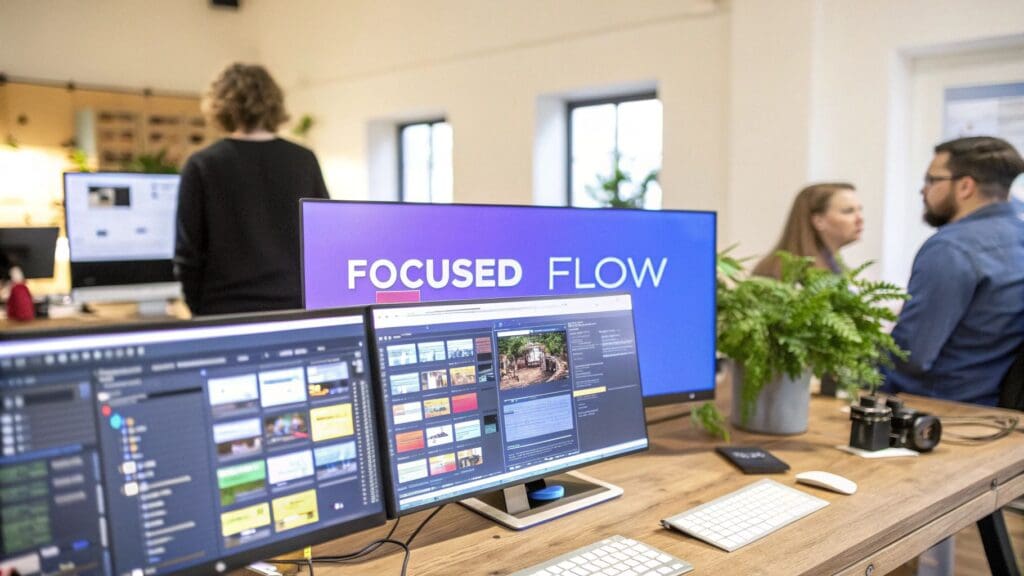In a busy creative studio, the pressure to deliver exceptional work on tight deadlines is constant. Juggling client demands, managing complex projects, and fostering innovation leaves little room for inefficiency. Yet, common productivity roadblocks-from constant digital interruptions to poorly aligned technology-can silently drain your team's creative energy and damage the bottom line. This isn't about working harder; it's about working smarter. The key is to build a robust framework that supports deep work, streamlines collaboration, and removes technical friction.
This guide provides a detailed blueprint to help your team improve workplace productivity. We will explore nine powerful, IT-aligned strategies designed specifically for the unique demands of creative agencies. Forget generic advice-these are practical, implementable systems created to protect your team's most valuable asset: its creative focus. From disciplined time management techniques like Time Blocking and the Pomodoro Technique to project frameworks such as Agile and the Getting Things Done (GTD) system, each method is chosen for its real-world impact.
We will also cover how to leverage automation, optimise your physical and digital workspaces, and establish clear communication protocols to eliminate unnecessary noise. The goal is to move your team from a state of reactive chaos to one of focused, uninterrupted flow. Let's build a more productive, resilient, and organised creative environment together.
1. Time Blocking and Calendar Management
To truly improve workplace productivity, creative teams must move beyond reactive to-do lists and proactively structure their time. This is where time blocking, a strategy popularised by figures like Cal Newport and Bill Gates, excels. Instead of a never-ending list of tasks, you schedule specific, non-negotiable blocks of time in your calendar for everything you need to accomplish-from deep work to administrative chores.
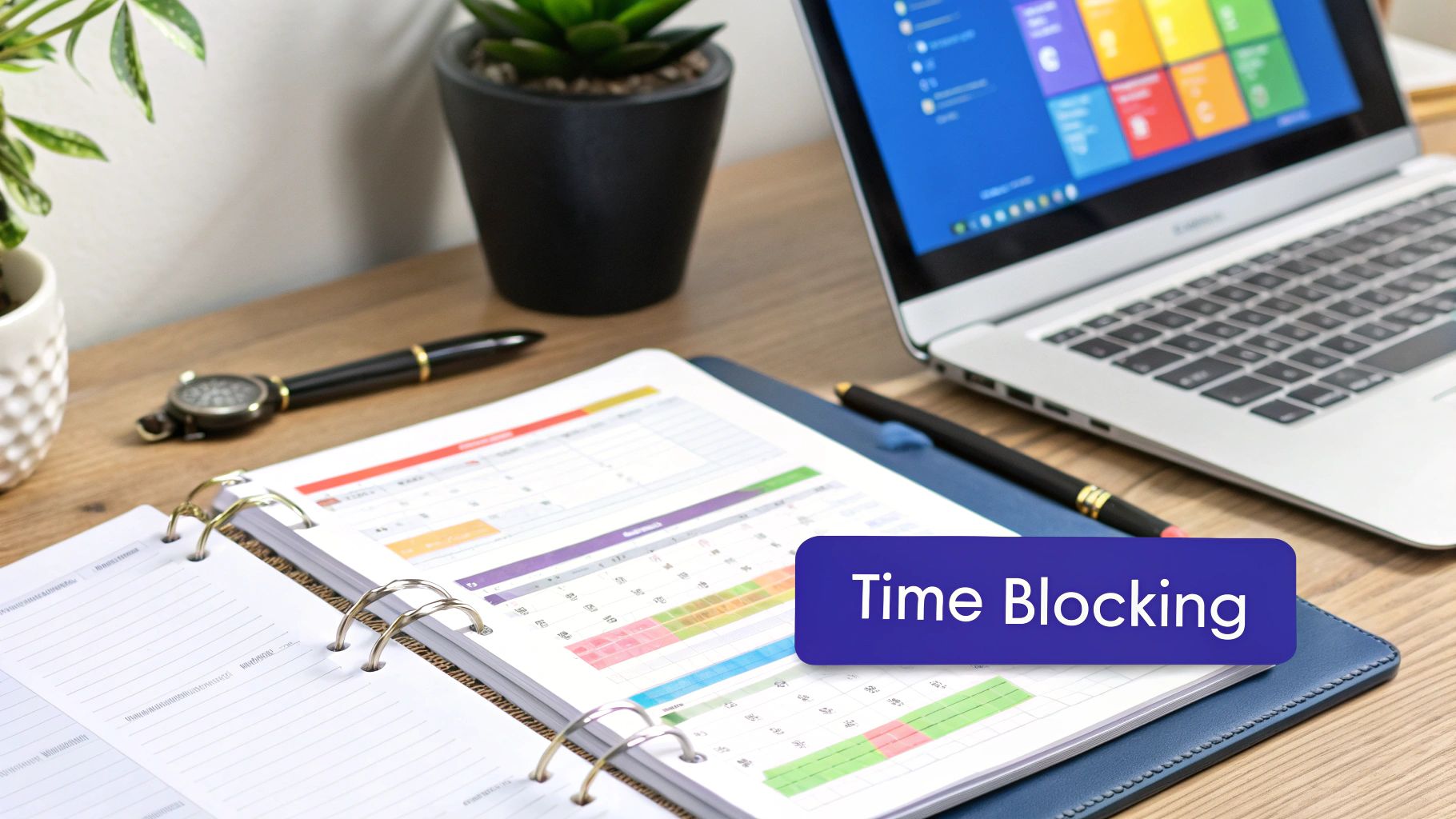
This method forces you to confront the reality of how much time you actually have, promoting realistic planning and protecting your most valuable asset: focused attention. For creative agencies, this means dedicating uninterrupted blocks for design sprints, copywriting, or strategy development, ensuring that high-value cognitive work isn't constantly derailed by notifications and ad-hoc requests. It's a system that helps you intentionally allocate your energy to what matters most.
How to Implement Time Blocking
Successfully adopting this technique requires a systematic approach. By being deliberate with your schedule, you can reclaim control over your day and significantly boost output.
- Start with Deep Work: Allocate 90-minute blocks for your most demanding creative tasks. This duration is often ideal for entering a state of flow without leading to burnout.
- Buffer Your Meetings: Schedule 15-minute buffers between consecutive meetings. This allows for mental reset, travel time within the office, or final preparation, preventing back-to-back meeting fatigue.
- Colour-Code Your Calendar: Assign different colours to categories of work-for example, blue for client meetings, green for focused creative work, and orange for administrative tasks. This provides a clear, at-a-glance overview of your day.
- Batch Your Communications: Dedicate two or three specific blocks per day for checking and responding to emails and Slack messages. This prevents constant context-switching and preserves your focus during deep work periods.
Key Insight: Time blocking isn't about rigid inflexibility; it's about making conscious decisions about your time. When unexpected tasks arise, you can intentionally adjust your blocks rather than letting your day descend into chaos.
Review your schedule at the end of each week to see what worked and what didn't, then refine your approach. For a deeper dive into optimising your daily schedule, explore how to create an effective time blocking schedule that truly works. By mastering this discipline, your team can transform its approach to daily work and unlock new levels of productivity.
2. The Pomodoro Technique
To consistently improve workplace productivity without succumbing to burnout, creative professionals can turn to the Pomodoro Technique. Developed by Francesco Cirillo, this time management method breaks work into focused, 25-minute intervals-known as "pomodoros"-separated by short breaks. The system is built on the idea that frequent rests can improve mental agility and sustain high levels of concentration over a long day.
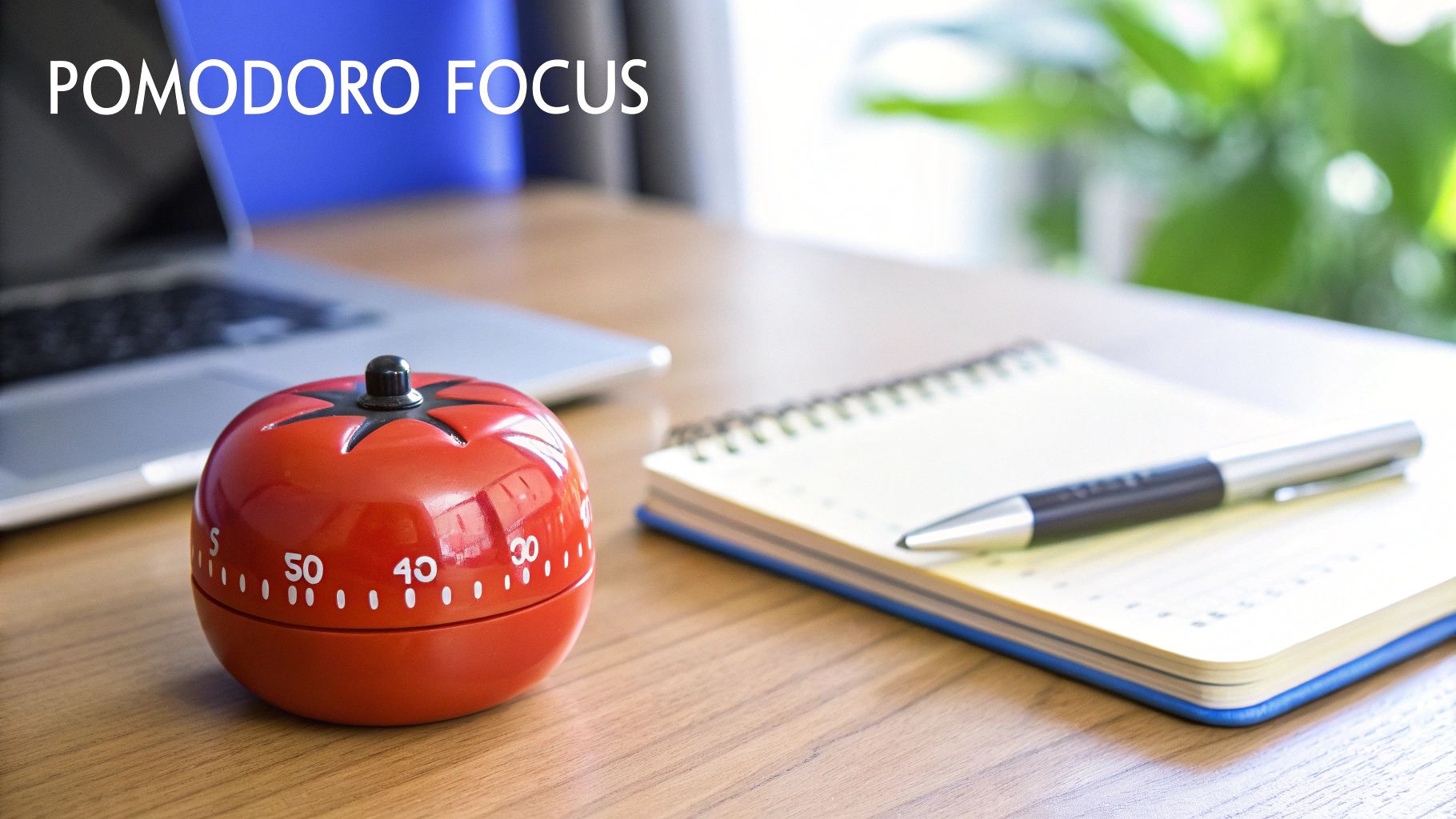
This approach is especially powerful for creative tasks that demand deep focus, such as UI design, content creation, or coding. By committing to a single task for a short, intense burst, you minimise distractions and build momentum. The scheduled breaks then act as a crucial reset, preventing the mental fatigue that often derails an entire afternoon. For agencies, this means a designer can complete several focused pomodoros on a wireframe, ensuring steady progress rather than sporadic bursts of activity interrupted by notifications.
How to Implement The Pomodoro Technique
Adopting this cyclical system requires discipline, but its structure is simple to follow. The key is committing fully to both the work and the rest periods to maximise the benefits.
- Plan Your Pomodoros: Before starting, list the tasks you want to accomplish and estimate how many pomodoros each will require. This creates a clear action plan for your day.
- Use a Physical Timer: While phone apps are available, a dedicated physical timer helps you avoid the temptation of checking your phone. The ticking sound can also create a psychological trigger for focus.
- Use Breaks Effectively: Your 5-minute breaks are for disengaging completely. Stand up, stretch, grab a glass of water, or do some light meditation-avoid checking emails or social media. After four pomodoros, take a longer 15-30 minute break.
- Track and Adjust: Log how many pomodoros a task actually takes. This data helps you make more accurate time estimates in the future. If the 25-minute interval feels too short or long, experiment with 45 or even 90-minute blocks to find what suits your workflow.
Key Insight: The Pomodoro Technique's real strength lies in its ability to train your focus. By consistently resisting interruptions for 25 minutes, you are actively strengthening your ability to concentrate for extended periods.
This method transforms a daunting workload into a series of manageable, bite-sized sprints. Whether you're a freelance writer, a developer at a company like Shopify, or part of a bustling marketing agency, this technique provides a reliable framework for getting meaningful work done every single day.
3. Getting Things Done (GTD) System
To truly improve workplace productivity, it’s essential to free the mind from the burden of remembering tasks. The Getting Things Done (GTD) system, created by productivity consultant David Allen, is a comprehensive methodology built on this principle. Its core philosophy is that the mind is for having ideas, not holding them. By capturing everything that commands your attention in a trusted external system, you can achieve a state of mental clarity and focus on the task at hand.
This system is particularly effective for creative professionals who juggle diverse projects, client feedback, and spontaneous ideas. Instead of letting a brilliant concept for a campaign get lost amidst administrative follow-ups, GTD provides a structured way to capture, clarify, and organise every input. It allows creatives to trust that nothing will fall through the cracks, enabling them to engage fully in high-value activities like brainstorming, designing, and strategy without mental clutter.
How to Implement the GTD System
Adopting GTD is a five-step process that transforms how you manage your commitments. By systematically processing your inputs, you can create a reliable framework that supports your creative workflow and boosts output.
- Capture and Clarify: Begin by capturing every task, idea, and commitment in a single inbox-be it a physical tray, a digital app, or an email folder. Then, process each item by asking: "Is it actionable?" If not, trash it, file it as a reference, or place it on a 'someday/maybe' list.
- Organise by Context: If an item is actionable, decide the very next physical action required. Organise these actions by the context needed to complete them-for example, '@computer', '@office', or '@client-call'. This makes it easy to see what you can do at any given moment.
- Define Clear Projects: For any outcome requiring more than one action step, define it as a 'project'. Maintain a separate list of all your projects to keep a high-level overview of your commitments, from launching a new website to finalising a brand style guide.
- Schedule Weekly Reviews: This is the cornerstone of making GTD work long-term. Block out a non-negotiable time each week to review all your lists, clear your inboxes, and get current. This weekly ritual ensures the system remains a trusted and functional tool.
Key Insight: GTD is not about doing more work-it's about being more present and effective with the work you choose to do. The system's power lies in creating the mental space necessary for creativity and strategic thinking to flourish.
Start by mastering the 'capture' and 'clarify' steps before rolling out the entire system. By externalising your mental to-do list, you can reduce stress and dramatically improve workplace productivity, ensuring your best ideas receive the attention they deserve. For a complete guide, David Allen's official Getting Things Done website offers extensive resources to help you get started.
4. Automation and AI-Powered Tools
To significantly improve workplace productivity, creative agencies must strategically embrace automation and artificial intelligence. These technologies excel at handling repetitive, time-consuming tasks, freeing up your team to focus on high-value creative and strategic work. From simple workflow automations to sophisticated AI assistants, the goal is to augment human capabilities, not replace them.
The modern creative environment is filled with opportunities for intelligent automation. Platforms like Zapier or IFTTT can connect disparate apps-for example, automatically creating a project task in Asana when a client signs a contract in DocuSign. Similarly, AI tools like Microsoft Copilot can draft emails, summarise long documents, or even generate initial creative concepts, dramatically reducing the administrative burden. Leveraging cutting-edge technology can significantly streamline workflows; discover how to achieve this by using AI-powered meeting summaries to improve productivity and reclaim hours once lost to manual note-taking.
How to Implement Automation and AI
Successfully integrating these tools requires a thoughtful approach rather than a haphazard adoption of the latest technology. A clear strategy ensures that automation serves your team's specific needs.
- Start with Repetitive Tasks: Identify the most mundane, recurring activities in your daily operations. This could be data entry, social media posting, or generating standard reports. Automating these provides an immediate and measurable return on investment.
- Map Existing Workflows: Before introducing new tools, document your current processes from start to finish. This helps you pinpoint bottlenecks and identify the most impactful opportunities for automation, ensuring you're solving the right problem.
- Test in Small Batches: Roll out new automations with a small, controlled group or on a single project. This allows you to identify and fix any issues before implementing the new process across the entire organisation, minimising disruption.
- Regularly Audit and Optimise: Automation is not a "set-and-forget" solution. Schedule regular reviews-quarterly or bi-annually-to ensure your automated processes are still efficient, relevant, and aligned with your current business goals.
Key Insight: The most effective use of AI and automation is to handle the predictable elements of work, which in turn frees up human intellect for the unpredictable, creative challenges that drive real value for clients.
By systematically offloading routine tasks to technology, your agency can create more space for innovation and strategic thinking. To explore this topic further, discover more about 5 ways AI is transforming business in the UK and how to apply these changes to your own operations.
5. Deep Work and Distraction Elimination
To truly improve workplace productivity, creative professionals must protect their most valuable skill: the ability to focus intensely on cognitively demanding tasks. This is the core of Deep Work, a concept popularised by author Cal Newport. It involves dedicating uninterrupted periods to high-value activities, systematically removing the constant barrage of notifications, meetings, and shallow tasks that fragment attention and hinder genuine progress.
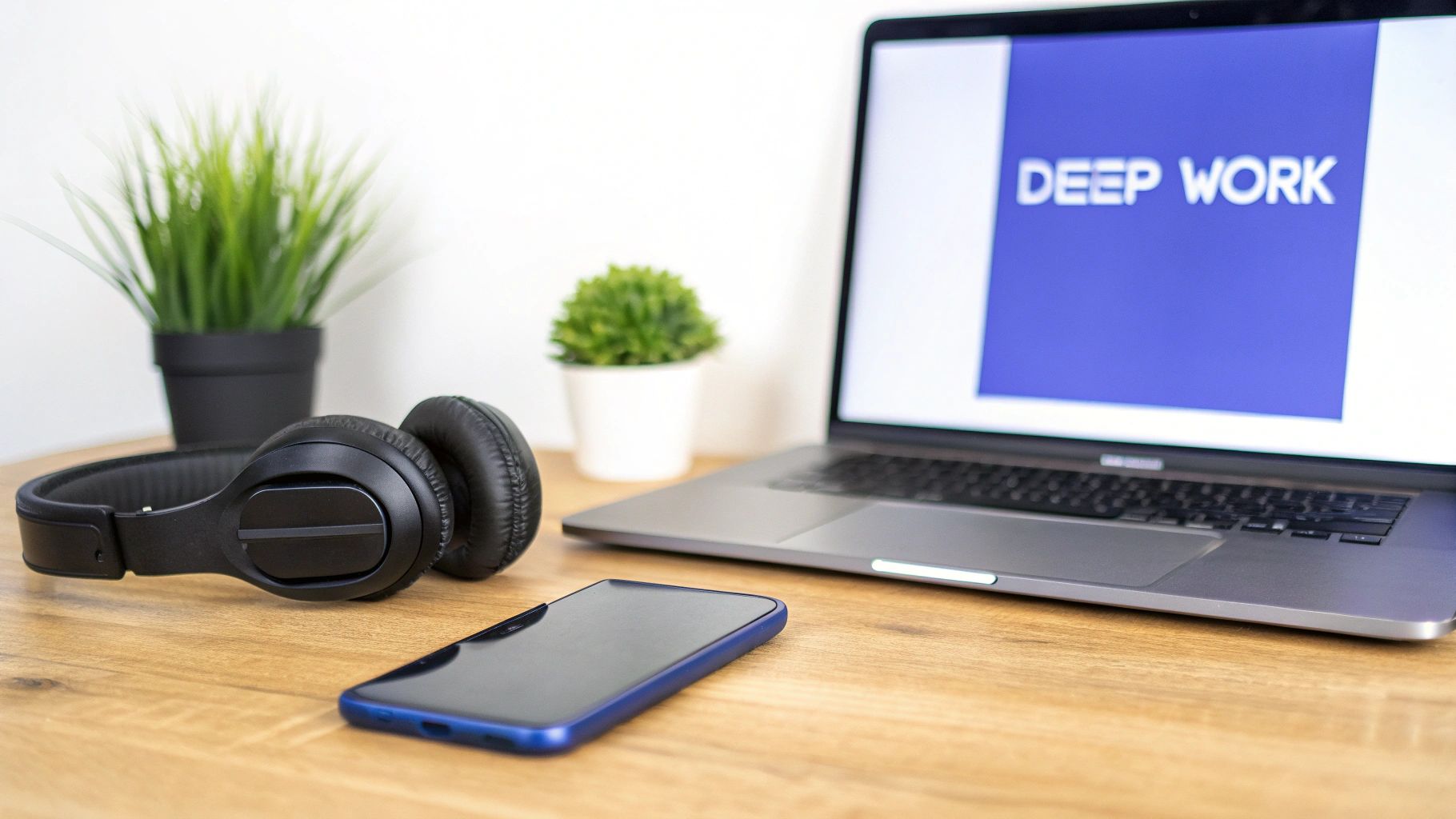
This philosophy champions the idea that exceptional creative output-be it groundbreaking design, compelling copy, or intricate strategy-is born from sustained, distraction-free concentration. Rather than multitasking, which is a myth, you create an environment designed for singular focus. Think of J.K. Rowling renting a hotel room to finish a novel or Bill Gates' famous 'Think Weeks'. These are extreme examples of a powerful principle: great work requires deep, uninterrupted thought.
How to Implement Deep Work
Adopting a deep work practice requires a deliberate and structured effort to re-engineer your workday and environment. By creating clear boundaries, you can cultivate the focus needed for breakthrough results.
- Schedule Deep Work Blocks: Start by dedicating a 90-minute block in your calendar each day for your most important creative task. Treat this time as a non-negotiable appointment.
- Create a Shutdown Ritual: At the end of your workday, create a consistent routine to signal to your brain that it's time to disengage. This could involve organising your to-do list for the next day and saying a specific phrase like "shutdown complete".
- Eliminate Digital Distractions: Use website and app blockers during your focused sessions. Put your phone on silent or in airplane mode and move it out of your immediate line of sight to remove the temptation.
- Communicate Your Schedule: Inform your colleagues about your deep work periods. This sets clear expectations and helps create a culture where focused time is respected, similar to Basecamp's 'Library Rules' policy.
Key Insight: Deep work isn't about working longer hours; it's about maximising the value produced during the hours you do work. The goal is to increase the intensity of your focus, not the duration of your workday.
Track your deep work hours each week to measure progress and identify what conditions best support your focus. For a more detailed guide, discover techniques on how to focus better at work and make deep work a cornerstone of your productivity. By prioritising deep work, you empower your team to produce higher-quality creative work in less time.
6. Agile and Scrum Methodologies
While originally designed for software development, Agile and Scrum methodologies offer a powerful framework to improve workplace productivity for creative teams. These iterative approaches prioritise short work cycles (sprints), regular feedback, continuous improvement, and adaptive planning. Instead of a single, long-term project plan, work is broken down into manageable chunks, allowing teams to deliver value quickly and pivot based on client feedback.
This model is a significant departure from traditional, linear "waterfall" project management. For creative agencies, this means a campaign element can be developed, reviewed, and refined in a matter of weeks, not months. The focus on delivering working results frequently ensures that projects stay aligned with client expectations and market realities, a principle successfully adopted by organisations like Spotify and Amazon in their product development cycles.
How to Implement Agile and Scrum
Adopting Agile requires a shift in mindset towards collaboration, transparency, and adaptability. By structuring work in this way, creative teams can build momentum and consistently deliver high-quality results.
- Start with Short Sprints: Begin with one or two-week sprints. This allows the team to learn the process, build a rhythm, and see tangible progress quickly without feeling overwhelmed.
- Prioritise the Retrospective: Treat the sprint retrospective as the most crucial meeting. This is the dedicated time for the team to honestly discuss what went well, what didn't, and what concrete changes can be made to improve the next sprint.
- Keep User Stories Small: Ensure that each task or "user story" is small enough to be fully completed within a single sprint. This prevents work from spilling over and helps maintain a sense of accomplishment and velocity.
- Use Visual Boards: Employ a physical or digital Kanban or Scrum board (like Trello or Jira) to visualise workflow. This makes progress, bottlenecks, and priorities transparent to the entire team at a glance.
Key Insight: The goal is not to follow Agile or Scrum rules rigidly, but to adapt the principles to your team's unique creative process. Flexibility is a core tenet-the framework should serve the team, not the other way around.
By breaking down large projects, you create more opportunities for feedback and course correction, which is vital for managing expectations. For a closer look at keeping projects on track, explore how to avoid the common pitfalls of managing project scope creep. This iterative approach helps ensure the final deliverable is precisely what the client needs.
7. Priority Matrix and Eisenhower Method
To truly improve workplace productivity, creative teams must move beyond simply reacting to the next urgent request and instead focus on what is genuinely important. The Eisenhower Method, popularised by Stephen Covey, provides a powerful decision-making framework for this. It helps you categorise tasks based on two dimensions-urgency and importance-preventing the common pitfall of letting minor but loud tasks dominate your schedule.
The following decision tree illustrates how to apply the Eisenhower Matrix to every task that lands on your plate.
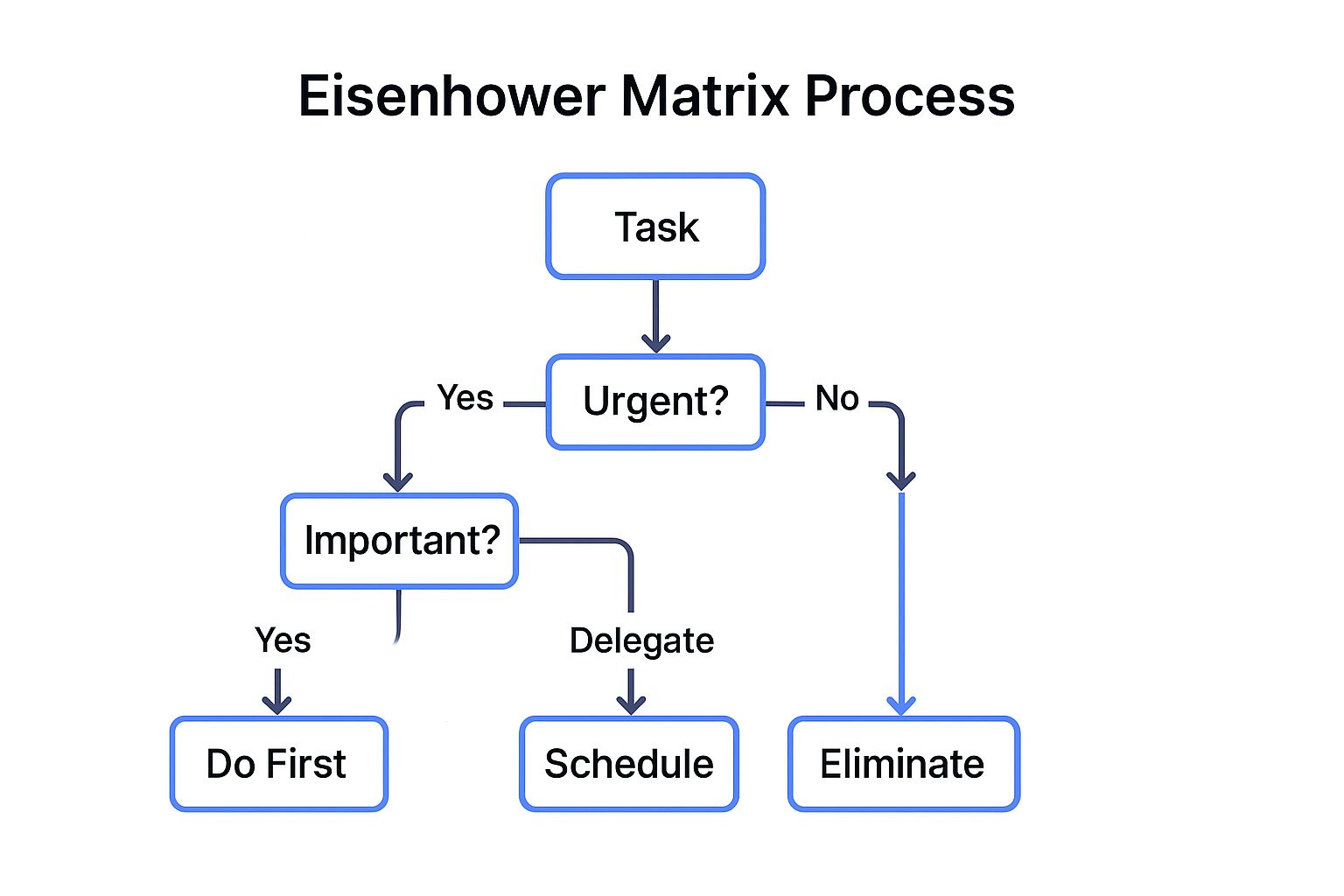
This method forces you to pause and evaluate each task's true value before committing time and resources. For a busy design studio, this means distinguishing between a last-minute, low-impact client tweak (Urgent, Not Important) and strategic work on a high-value campaign (Important, Not Urgent). By systematically sorting tasks into four clear quadrants-Do, Schedule, Delegate, or Eliminate-you can ensure your energy is directed towards activities that drive long-term success.
How to Implement the Eisenhower Method
Adopting this matrix requires discipline, but it empowers you to take control of your workload and focus on high-impact activities rather than just reacting to constant demands.
- Define 'Important': Your definition of "important" should directly align with your team's long-term goals and strategic objectives. A task is important if it moves you closer to achieving these key results.
- Focus on Quadrant 2: Aim to spend the majority of your time on tasks that are Important but Not Urgent. This is the quadrant of strategic planning, creative development, and relationship-building-the activities that prevent future crises.
- Use Delegation Strategically: View the "Delegate" quadrant as a development opportunity. Assigning urgent but less critical tasks to junior team members can build their skills and free up senior creatives for high-value work.
- Learn to Eliminate: Be ruthless with Quadrant 4 tasks (Neither Urgent nor Important). Saying "no" to time-wasting activities is a critical skill for maintaining focus and protecting your team's creative energy.
Key Insight: The power of the Eisenhower Matrix isn't just in what you choose to do; it's in the clarity and confidence it gives you to intentionally delegate or eliminate what you shouldn't be doing.
Review and reorganise your matrix at the start of each week to adapt to new priorities. For a deeper understanding of how to apply this in a fast-paced environment, consider how military leaders use this exact method for tactical decision-making. By mastering this simple framework, your team can shift from being busy to being truly productive.
8. Workplace Environment Optimisation
A thoughtfully designed workspace is a cornerstone to improve workplace productivity, yet it is often overlooked. Workplace environment optimisation involves the strategic organisation of your physical and digital spaces to enhance focus, creativity, and efficiency. Pioneered by companies like Herman Miller and Steelcase, this approach moves beyond simple tidiness to consider ergonomics, lighting, noise levels, and even air quality.
For creative agencies, an optimised environment directly impacts output by reducing physical discomfort and mental friction. When designers, writers, and strategists are comfortable and focused, they can more easily enter a state of deep work. As seen in innovative offices designed by Pixar and Google, creating spaces that foster both individual concentration and spontaneous collaboration is key to unlocking a team’s full potential.
How to Implement Workplace Environment Optimisation
Transforming your workspace from a source of distraction into a hub of productivity requires intentional design choices. By focusing on key environmental factors, you can create a setting that actively supports high-quality work.
- Invest in Ergonomics First: Prioritise a high-quality, adjustable chair and a proper monitor setup. Your monitor should be positioned to avoid glare, with the top of the screen at or slightly below eye level to prevent neck strain.
- Create Designated Work Zones: If space allows, establish different areas for different types of work. A quiet zone for deep focus, a comfortable lounge for brainstorming, and a collaborative area for team meetings can cater to diverse needs.
- Introduce Natural Elements: Use plants to improve air quality, reduce stress, and add a touch of nature to the office. Maximise natural light where possible, as it is proven to boost mood and regulate circadian rhythms.
- Declutter and Organise Regularly: A tidy desk reduces cognitive load and minimises distractions. Schedule five minutes at the end of each day to clear your physical and digital desktops, ensuring a fresh start for the next morning.
Key Insight: Your environment is not a passive backdrop; it is an active tool. The goal is to consciously shape your surroundings to make productive behaviours easier and distracting ones harder, thereby engineering a space that works for you.
To truly transform your physical workspace, delve into the latest top office desk setup ideas to boost productivity for more detailed guidance. By systematically enhancing your environment, you create a powerful foundation for sustained focus and creative excellence.
9. Communication Systems and Protocols
To genuinely improve workplace productivity, creative teams need to move from chaotic communication to structured, intentional systems. Establishing clear communication protocols means defining which tools to use for specific purposes, setting expectations for response times, and standardising how information is shared. This approach, championed by companies like Basecamp and GitLab, transforms communication from a constant source of distraction into a powerful facilitator of focused work.
Without formal protocols, a simple query can trigger a cascade of notifications across email, instant messaging, and project management tools, fracturing concentration. By creating a deliberate framework, creative agencies can ensure that urgent messages are seen quickly, important updates are properly documented, and deep work periods are respected. This isn't about restricting communication; it's about making every interaction more efficient and purposeful, freeing up cognitive resources for creative problem-solving.
How to Implement Communication Protocols
Adopting a structured communication system requires team-wide buy-in and clear documentation. By being deliberate about how your team connects, you can minimise noise and maximise clarity.
- Assign Channels to Purposes: Designate specific tools for specific tasks. Use instant messaging (like Slack or Teams) for quick, informal questions, email for formal external communication, and your project management platform for all task-related discussions.
- Establish Core Communication Hours: Define a window of time when team members are expected to be available for synchronous communication. This respects flexible working arrangements while ensuring there is overlap for collaborative needs.
- Implement a 'No Meetings Day': Follow the lead of companies like Shopify by introducing a meeting-free day, such as a "Focus Wednesday". This guarantees at least one day per week for uninterrupted deep work.
- Use Statuses and Do Not Disturb: Encourage the team to use status updates to signal when they are in deep work, in a meeting, or away from their desk. This manages response expectations without needing a direct conversation.
Key Insight: Effective communication protocols are not about creating rigid rules but about building shared understanding. The goal is to reduce ambiguity and the mental energy wasted on figuring out how, when, and where to communicate.
Regularly review your communication stack and protocols with your team to ensure they still serve their purpose. For an excellent example of documented communication standards, GitLab's publicly available remote work handbook offers a masterclass in clarity. By organising your communication, you pave the way for a more focused and productive work environment.
9 Workplace Productivity Methods Comparison
| Methodology / Technique | Implementation Complexity 🔄 | Resource Requirements ⚡ | Expected Outcomes 📊 | Ideal Use Cases 💡 | Key Advantages ⭐ |
|---|---|---|---|---|---|
| Time Blocking and Calendar Management | Moderate: initial setup and discipline needed | Medium: digital calendar tools and time | Improved focus, reduced multitasking, better work-life balance | Individuals needing structure and scheduling clarity | Reduces decision fatigue; protects deep work periods |
| The Pomodoro Technique | Low to Moderate: simple timer-based practice | Low: timer or app | Sustained high focus with regular breaks | Tasks benefiting from time-sliced attention spans | Prevents burnout; reduces procrastination |
| Getting Things Done (GTD) System | High: steep learning curve, setup & maintenance | Medium to High: tools + consistent review time | Comprehensive task capture and stress reduction | Complex task loads requiring detailed organization | Externalizes tasks; improves prioritization |
| Automation and AI-Powered Tools | High: significant initial development and setup | High: software, AI tools, maintenance | Time saved on repetitive tasks; error reduction | Repetitive workflows, scaling operations | Eliminates manual work; enables focus on strategy |
| Deep Work and Distraction Elimination | Moderate to High: requires habit change and environment design | Low to Medium: workspace adjustments | Dramatic quality and depth of output | Knowledge work needing deep concentration | Boosts skill development; reduces task-switching |
| Agile and Scrum Methodologies | High: cultural change, experienced facilitation needed | Medium: collaboration tools and training | Faster value delivery; team alignment | Team projects, product development with feedback | Enhances collaboration; regular improvement cycles |
| Priority Matrix and Eisenhower Method | Low: simple framework to apply | Low: pen and paper or basic tools | Better prioritization; focus on important tasks | Individuals or teams overwhelmed by urgent tasks | Simple visual system; improves strategic thinking |
| Workplace Environment Optimization | Moderate: investment in physical/digital setup | Medium to High: ergonomic furniture, lighting | Improved focus, comfort, creativity | Individuals or organizations aiming productivity boost | Enhances mental clarity; reduces physical strain |
| Communication Systems and Protocols | Moderate: requires policy design and enforcement | Medium: communication platforms | Reduced confusion; improved coordination | Teams needing clear communication channels | Scales communication; minimizes interruptions |
Building a Calmer, More Productive Creative Future
Navigating the journey to improve workplace productivity is not about a single, magical solution. Instead, it’s about a deliberate, layered approach-a commitment to building systems that empower your creative team rather than overwhelming them. We’ve explored a powerful suite of strategies, from the granular focus of the Pomodoro Technique to the high-level project organisation of Agile methodologies. Each of these methods offers a pathway to reclaiming control over time, attention, and creative energy.
The common thread weaving through these disparate techniques is the principle of intentionality. It's about consciously deciding where your team’s focus should be and then creating an environment that protects that focus. By implementing systems like GTD, you transform mental clutter into actionable steps. By using a Priority Matrix, you ensure that effort is consistently applied to what truly matters, moving beyond the tyranny of the urgent.
Synthesising Strategies for Maximum Impact
The true power lies not in adopting one of these frameworks in isolation, but in synthesising them into a cohesive operational philosophy that fits your agency’s unique culture.
- For Individual Focus: Combine Time Blocking with the principles of Deep Work. Schedule uninterrupted blocks for complex creative tasks and actively eliminate the digital and physical distractions that fragment concentration.
- For Team Collaboration: Integrate Agile and Scrum methodologies with clear Communication Protocols. This ensures that collaborative sprints are efficient, feedback is constructive, and everyone understands the channels for different types of interaction.
- For Overall Organisation: Use the Getting Things Done (GTD) system as a personal foundation for each team member, while employing the Eisenhower Matrix at a leadership level to guide strategic priorities for the entire studio.
This holistic approach recognises that productivity is a multi-faceted challenge. It requires both individual discipline and collective alignment. When your team members feel empowered to manage their own workflows within a supportive, well-defined structure, the result is a significant reduction in stress and a substantial increase in meaningful output.
The Technological Bedrock of Creative Flow
Ultimately, every one of these productivity-enhancing strategies relies on a stable and unobtrusive technological foundation. Your ability to implement time blocking, manage a digital Scrum board, or maintain a distraction-free digital workspace is directly dependent on the reliability of your IT infrastructure. When your tools are slow, your network is unreliable, or your communication platforms are clunky, they become sources of friction that actively undermine your efforts to improve workplace productivity.
The most productive technology is the technology you don’t have to think about. It works quietly and reliably in the background, enabling creativity rather than demanding constant troubleshooting.
Therefore, the most critical-yet often overlooked-step is to ensure your IT environment is not a bottleneck but a catalyst. This is where a human-centred approach to technology becomes paramount. It’s about building a system that serves your people, automating routine tasks to free up cognitive load, and ensuring security without creating cumbersome barriers. By prioritising a calm, resilient, and well-managed IT ecosystem, you create the essential groundwork upon which all other productivity methods can flourish. This transforms the pursuit of efficiency from a constant battle against technical issues into a focused effort on what your agency does best: creating exceptional work.
A robust IT infrastructure is the foundation of a highly productive creative agency. At InfraZen Ltd, we specialise in providing calm, human-centred IT support and strategy for UK-based creative businesses, ensuring your technology empowers your team instead of hindering it. Discover how we can help you build a more focused and efficient workplace at InfraZen Ltd.

